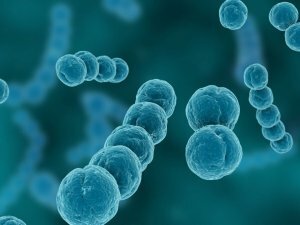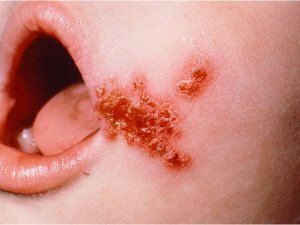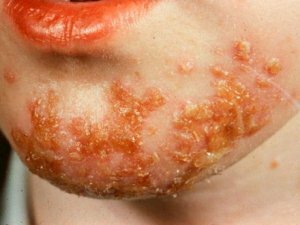Streptococcus
 Streptococcus what is it? The name "streptococcal infection" combines diseases, which are called hemolytic streptococcus. This is a very diverse disease: and quite "innocent" inflammatory processes on the skin, in the throat, nose, nasopharynx, ears, and scarlet fever, and erysipelatous inflammation, and, finally, severe streptococcal pneumonia accompanied by lung abscess and sepsis. In modern medicine, the problem of streptococcal infection, and especially streptococcal sepsis - is one of the most urgent problems in both surgery and therapy.
Streptococcus what is it? The name "streptococcal infection" combines diseases, which are called hemolytic streptococcus. This is a very diverse disease: and quite "innocent" inflammatory processes on the skin, in the throat, nose, nasopharynx, ears, and scarlet fever, and erysipelatous inflammation, and, finally, severe streptococcal pneumonia accompanied by lung abscess and sepsis. In modern medicine, the problem of streptococcal infection, and especially streptococcal sepsis - is one of the most urgent problems in both surgery and therapy.
What is streptococcal infection
Streptococcal infection is caused by hemolytic streptococcus. There are many types and groups of streptococci, so after a streptococcal infection, immunity develops only to a certain type of hemolytic streptococcus, in addition, this immunity is very fragile. This explains the possibility of developing other forms of streptococcal infection in one person - tonsillitis, otitis, rhinitis, etc.
 Hemolytic streptococcus produces poisonous substances - exotoxins, which increase general intoxication. One of the components of exotoxin is the so-called erythrogenic Dick toxin, or general toxin, rash toxin. It determines the general intoxication of the body and the development of scarlet fever, and other toxins ensure its penetration into tissues. Streptococcus is quite stable in the external environment, it tolerates freezing well, in dried blood or pus persists for weeks and months, when heated to 70 degrees it persists for one hour. However, under the influence of disinfectants, the microbe quickly dies. Streptococcus is very sensitive to the action of penicillin and erythromycin.
Hemolytic streptococcus produces poisonous substances - exotoxins, which increase general intoxication. One of the components of exotoxin is the so-called erythrogenic Dick toxin, or general toxin, rash toxin. It determines the general intoxication of the body and the development of scarlet fever, and other toxins ensure its penetration into tissues. Streptococcus is quite stable in the external environment, it tolerates freezing well, in dried blood or pus persists for weeks and months, when heated to 70 degrees it persists for one hour. However, under the influence of disinfectants, the microbe quickly dies. Streptococcus is very sensitive to the action of penicillin and erythromycin.

How can you get streptococci
The source of streptococcal infection is most often a sick person, much less often - a carrier. Sources of infection can be patients with any form of streptococcal infection, but the greatest danger is represented by patients with defeat of throat and upper respiratory tract. During coughing, sneezing, talking, streptococci with droplets of saliva "sprinkle" on others. In addition, when dry, they mix with dust and can be stored indoors for a long time. In the presence of streptodermia - purulent lesions on the skin caused by streptococcus, a contact path of infection is possible, as well as the development of foodborne toxic infections if the food was prepared by a person suffering from streptodermia of the hands.

Who is affected by the disease
Susceptibility to streptococcus is high in all people, but above all it is in childhood and young age, slightly decreases after 40-50 years. Streptococcal disease often occurs in the fall and winter. The place of penetration of streptococcus into the human body most often are tonsils and upper respiratory tracts, less often - damaged skin( for example, wounds, intertrigo, scrapes, burns, abrasions).There, a primary inflammatory focus develops, in which microorganisms multiply, toxins and products of decomposition of tissues and microbial bodies accumulate. From this local focus, the absorption of toxins and degradation products occurs, as well as the spread of streptococcus, resulting in the development of a pathological process in the body.
Components of the pathological process with streptococcus
 With streptococcal infection, three main components of the pathological process are distinguished: infectious, toxic and allergic.
With streptococcal infection, three main components of the pathological process are distinguished: infectious, toxic and allergic.
Infectious syndrome - a change in the body, which are directly related to the multiplication and life activity of the microbe. At the site of the introduction of streptococcus develops catarrhal( least serious) inflammation, which can go into purulent or necrotic. At the same time, because of the high aggressiveness of the microorganism, it rapidly spreads from the primary focus to surrounding tissues: to the lymph nodes with the development of lymphadenitis and adenophlegmon. From the pharynx - in the middle ear and paranasal sinuses with the development of otitis, mastoiditis, sinusitis. From any focus of inflammation, streptococcus can penetrate the blood, and then it is possible to spread the infection so-called hematogenous( through the bloodstream) pathway with the development of foci of purulent infection in any organ.
Signs of streptococcal infection
Toxic syndrome, or intoxication, develops as a result of the absorption of toxins released by hemolytic streptococcus. The main manifestations of intoxication are fever, chills, palpitation, deterioration of well-being, nausea, and sometimes vomiting. There may be a headache, dizziness, confusion.
The allergic component is due to the fact that streptococcal protein is foreign to the body, and therefore - an allergen, which causes an allergic "mood."This creates prerequisites for the development of jade, rheumatism, and collagenoses.
Incubation period of streptococcus
 The incubation period with streptococcal infection lasts from several hours to 4-5 days. The onset of the disease is most often acute, with a rapid development of the local inflammatory process and general intoxication. In the classification of streptococcal infection, mainly local infectious processes and generalized forms are singled out, scarlet fever and erysipelas are highlighted.
The incubation period with streptococcal infection lasts from several hours to 4-5 days. The onset of the disease is most often acute, with a rapid development of the local inflammatory process and general intoxication. In the classification of streptococcal infection, mainly local infectious processes and generalized forms are singled out, scarlet fever and erysipelas are highlighted.
- Primarily local streptococcal diseases are streptoderma, phlegmon, abscess, lymphadenitis, lymphangitis, inflammation of wounds and burn surfaces.
- Bone lesions manifest in the form of arthritis and osteomyelitis.
- Lesions of throat and nasopharynx are rhinitis, pharyngitis, tonsillitis, tonsillitis, adenoiditis, otitis, sinusitis.
- Lesions of the respiratory tract include laryngotracheitis, bronchitis, pneumonia.
- Streptococcal lesions of the cardiovascular system are manifested in endocarditis and pericarditis.
- Organs of digestion - in peritonitis, cholecystitis, food toxic infections.
- The defeat of the genitourinary system can lead to nephritis, cystitis, pyelonephritis.
- The defeat of the nervous system - to purulent meningitis, an abscess of the brain.
In other words, a person does not have such an organ that could not become a target for a streptococcal infection. The main generalized form of streptococcal infection is septicopyemia( microbe in the blood) with the emergence of foci of infection in any organs and tissues.
Be Healthy!



